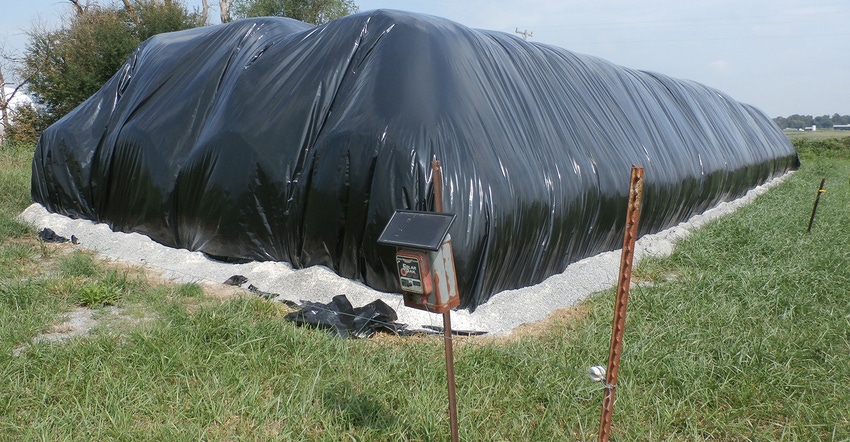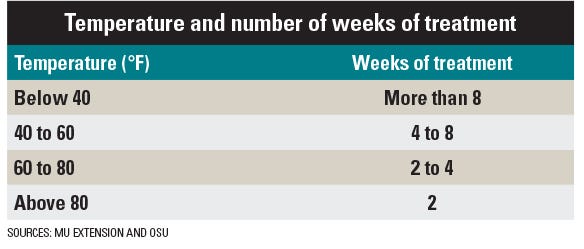July 5, 2018

Treatment of low-quality forages like late-cut fescue, wheat straw and fescue with anhydrous ammonia is not a new thing, according to Eldon Cole, University of Missouri Extension livestock specialist. He observed it back in the late 1970s and says it will work today.
According to Cole, the treatment improves the forage’s value. The forage becomes softer, improving palatability and digestibility. Cattle seem to love it and will clean it up better than untreated material. This improves animal intake by 20%.
“It’s best to stack, cover and apply the anhydrous as soon as possible after baling,” Cole says. However, farmers may need a refresher on just how to treat forages with anhydrous ammonia.

TREATMENT SOURCE: An anhydrous ammonia tank sits near stacked hay bales on the edge of a field. The tank provides the ammonia to treat poor-quality forage, making it more palatable for cattle.

How to ammoniate
Oklahoma State University (OSU) offers a guide to help farmers through the treatment process. Here are a few outtakes:
1. Determine forage weight. Weigh at least five large bales (20 small bales) in order to get a good indication of average weight. Different types of roughages have different densities and bale weights. Also, estimate roughage moisture content, because the amount of anhydrous ammonia applied is based on dry matter (DM).
2. Calculate the amount of anhydrous ammonia. Between 2% and 3% ammonia on a roughage DM basis (60 pounds per ton of DM) provides good results. Know how you will regulate the ammonia applied. OSU finds one option is to prepare the stack, calculate the total amount needed and then place an order for a tank that contains no more than the amount needed. Another alternative is to use the percentage gauge on the anhydrous ammonia tank to estimate the amount of ammonia that has been injected. The guide offers this example: If capacity of an anhydrous tank is 5,000 pounds, 1 percentage point on the tank gauge is 50 pounds (5,000 x 0.01). If the goal is to apply 1,500 pounds, the percentage unit’s change on the tank gauge would be 1,500 pounds ÷ 50 pounds per percentage unit.
3. Arrange bales. Farmers should arrange bales so that a single sheet of polyethylene (typically 40 by 100 feet) covers the entire stack, with at least 2 feet of overhang on all sides so the stack can be sealed. Researchers found with large round bales, a pyramid three bales high, with three forming the base, or two bales high, with four forming the base, works well. Don’t worry about placing the polyethylene between the ground and hay; not much ammonia will be lost there.
4. Cover the stack. Using a single sheet of polyethylene (6-ml or 8-ml thickness), cover the bales. Be careful not to tear the polyethylene, as holes and tears will result in loss of ammonia.
5. Add ammonia. Use a hose or pipe connected to the tank to supply the ammonia. Run it under the plastic toward the center of the stack. Ammonia will disperse throughout the stack. Apply ammonia slowly. Use no more than 30 pounds of ammonia per minute. Slow application will minimize ballooning and stretching of the polyethylene sheet. Anhydrous ammonia expands from a liquid to a gas when it is released from pressure. The warmer the temperature, the more the gas will expand. Applying the ammonia during late-evening and night hours, especially during midsummer, will minimize ballooning and stretching of the polyethylene.
6. Seal it up. To make the stack airtight, seal all edges of the polyethylene using at least 8 inches of soil, fine rock or other weighty material. In addition to creating an airtight seal, the soil around the base will also help to anchor the sheeting to prevent possible wind damage.
7. Determine treatment time. The length of time required for the stack to remain sealed depends on the environmental temperature, as shown below:

Keep hay covered until a few days prior to feeding. Uncovering the stack two days prior to feeding will allow any excess ammonia to escape.
Monitor the pile and plastic regularly to make sure there are no holes or tears in it, Cole says. “As forage is scarce this year,” he adds, “there will be a lot of hay and straw harvested that would be improved with the treatment of anhydrous.”
Sources: MU Extension, Oklahoma State University
You May Also Like




